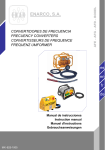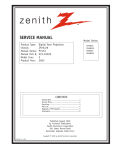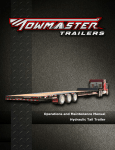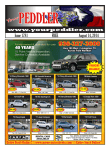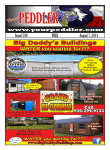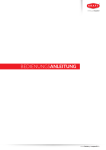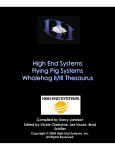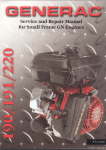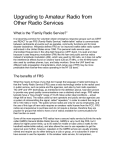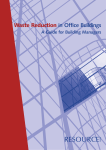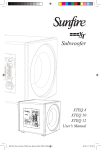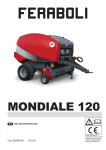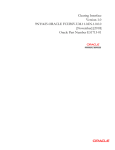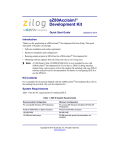Download Boxel QBer User Manual
Transcript
Boxel Manufacturing Incorporated Operators Manual The Boxel Hay QBer Boxel Manufacturing Incorporated April 28, 2011 Revision Sheet Boxel QBer User’s Manual Page i I have carefully assessed the User’s Manual for the (System Name). This document has been completed in accordance with the requirements of the HUD System Development Methodology. MANAGEMENT CERTIFICATION - Please check the appropriate statement. ______ The document is accepted. ______ The document is accepted pending the changes noted. ______ The document is not accepted. We fully accept the changes as needed improvements and authorize initiation of work to proceed. Based on our authority and judgment, the continued operation of this system is authorized. _______________________________ _____________________ NAME DATE Project Leader _______________________________ _____________________ NAME DATE Operations Division Director _______________________________ _____________________ NAME DATE Program Area/Sponsor Representative _______________________________ Boxel QBer User’s Manual _____________________ Page ii USER'S MANUAL TABLE OF CONTENTS Page # 1.0 2.0 3.0 GENERAL INFORMATION ............................................................................................ 1-1 1.1 Boxel Hay QBer Overview ..................................................................................... 1-1 1.2 Project References ................................................................................................ 1-3 1.3 Authorized Use Permission.................................................................................... 1-3 1.4 Points of Contact ................................................................................................... 1-4 1.4.1 Information ................................................................................................................. 1-4 1.4.2 Coordination .............................................................................................................. 1-5 1.4.3 Help Desk .................................................................................................................. 1-5 1.5 Organization of the Manual .................................................................................... 1-5 1.6 Acronyms and Abbreviations ................................................................................. 1-5 SYSTEM SUMMARY ..................................................................................................... 2-1 2.1 Parts ...................................................................................................................... 2-1 2.2 Hydraulics .............................................................................................................. 2-1 2.3 User Access Levels ............................................................................................... 2-3 OPERATING THE BOXEL HAY QBER .......................................................................... 3-0 3.1 Connecting QBer ................................................................................................... 3-1 3.1.a. Attaching the QBer Tractor 3.1.b. Attaching the QBer Truck 3.2 Using the QBer ...................................................................................................... 3-1 3.2.a. Ground Pick 3.2.b. Banding Preparation 3.2.c. Stacking Procedures 3.2.d. Compressing Bales 3.2.e. Banding Boxel QBer User’s Manual Page iii 3.2.f. Bale Dispersion 4.0 BOXEL HAY QBER SAFETY ......................................................................................... 4-1 4.x [System Function Name] ....................................................................................... 4-1 4.x.y 5.0 [System Sub-Function Name] .................................................................................... 4-1 4.2 Special Instructions for Error Correction ................................................................ 4-1 4.3 Caveats and Exceptions ........................................................................................ 4-1 PARTS & MAINTENCE .................................................................................................. 5-1 5.x [System Function Name] ....................................................................................... 5-1 5.x.y [System Sub-Function Name] .................................................................................... 5-1 5.2 Special Instructions for Error Correction ................................................................ 5-1 5.3 Caveats and Exceptions ........................................................................................ 5-1 5.4 Input Procedures and Expected Output ................................................................. 5-2 6.0 DIAGRAMS & PICTURES............................................................................................... 6-0 6.1 ZPak ZP26 ............................................................................................................ 6-1 6.2 Banding Set-up ...................................................................................................... 6-1 6.3 Stacking Formation……………………………………………………………….………6-1 6.4 7.0 Banding……………………………………………………………………..…………….6-1 TECHNICAL SPECIFICATIONS 7.1 Technical Specifications and Field Testing Data All rights reserved. Reproduction of any part of this manual in any form whatsoever without Boxel Manufacturing LLC. express written permission is forbidden. The contents of this manual are subject to change without notice. All efforts have been made to assure the accuracy of the contents of this manual. However, should any errors be detected, Boxel Manufacturing LLC. would greatly appreciate being informed of them. The above notwithstanding, Boxel Manufacturing LLC. can assume no responsibility for errors in this manual or their consequence. 2011 Boxel Manufacturing Incorporated. Caney, Oklahoma (U.S.A.) Boxel QBer User’s Manual Page iv 1.0 General Information 1.0 User’s Manual GENERAL INFORMATION 1.0 General Information 1.0 GENERAL INFORMATION 1.1 Boxel Hay QBer Overview The Boxel Manufacturing LLC. Hay QBer is designed to retrieve small square hay bales (14” x 18” x 40”) directly from the ground or from a hay baler and place them into a staging area holding a maximum of 5 bales. A laborer then stacks ten (10) bales from that staging area into the compressing platform and engages the hydraulics to compress the bales. After the completion of compression, the laborer uses a ZPak ZP26 to band the “bundle” with two (2) straps. The laborer then engages the dumping mechanism to disperse the bundle to the ground to complete the process. Major Functions: Retrieve individual hay bales from the ground Place individual hay bales into a staging area Compress ten individual hay bales into a single stable stack Access banding ten hay bales to for a single bundle of hay Eject ten banded hay bales to ground for later processing System Name: Boxel Manufacturing LLC. Hay QBer Hay Bundling System System category: Major application: performs clearly defined functions for which there is a readily identifiable security consideration and need User’s Manual Page 1-1 1.0 General Information General support system: provides general ADP or network support for a variety of users and applications Operational status: Operational Under development Undergoing a major modification General description System environment or special conditions User’s Manual Page 1-2 1.0 General Information 1.2 Project References Omni-Packaging Dennis Lashley (918) 461-7129 (800) 365-3626 Fax: (918) 461-8390 [email protected] Womack Machine Supply Jake Martens (580) 750-0509 (918) 833-3302 (918) 836-7763 Fax: (918) 838-2759 [email protected] 1.3 Authorized Use Permission Provide a warning regarding unauthorized usage of the system and making unauthorized copies of data, software, reports, and documents, if applicable. If waiver use or copy permissions need to be obtained, describe the process. The contents of the Hay QBer User Manual are available for individual user purposes only. Any commercial use of this manuals content requires permission from the content provider. See below for additional guidelines for individuals use information. User’s Manual Page 1-3 1.0 General Information Contents of the Hay QBer are provided upon purchase, lease or agreement through Boxel Manufacturing Incorporated and associated parties. Use of the Hay QBer literature is governed by the terms and conditions of the licenses and agreements between Boxel Manufacturing and the content provider (which may include but is not limited to a private commercial company, professional association, government agency, or academic institution, or non-profit organization). Individual license agreements between Boxel Manufacturing and the content provider take precedence over the general guidelines stated here. If you have questions about permitted uses for any content on Hay QBer web pages, please contact Boxel Manufacturing at: Boxel Mfg. Inc. ~ Vanguard Storage Module ~Lahman Fabrication, Llc. ~Boxel Farms 349 West Davis Creek Road,Caney, Oklahoma 74533 Toll Free: 1.866.889.0064 Office: 1.580.889.2444 Fax: 580.889.6446 Email: [email protected] Shop: Cell~405.200.2095 ~ Joe Shop: Cell~580.239.0819 ~ Brad Office: Cell~580.339.1179 ~ Vickie 1.4 Points of Contact 1.4.1 Information Provide a list of the points of organizational contact (POCs) that may be needed by the document user for informational and troubleshooting purposes. Include type of contact, contact name, department, telephone number, and e-mail address (if applicable). User’s Manual Page 1-4 1.0 General Information Points of contact may include, but are not limited to, help desk POC, development/maintenance POC, and operations POC. 1.4.2 Coordination Provide a list of organizations that require coordination between the project and its specific support function (e.g., installation coordination, security, etc.). Include a schedule for coordination activities. 1.4.3 Help Desk Provide help desk information including responsible personnel phone numbers for emergency assistance. 1.5 Organization of the Manual Provide a list of the major sections of the User’s Manual (1.0, 2.0, 3.0, etc.) and a brief description of what is contained in each section. 1.6 Optional Equipment User’s Manual Page 1-5 2.0 System Summary 2.0 User’s Manual SYSTEM SUMMARY 2.0 System Summary 2.0 SYSTEM SUMMARY This section provides a general overview of parts and a system summary of the QBer. 2.1 QBer Main Parts The QBer uses five major components which include: 1. The Hay Elevator 2. The Hay Staging and Collecting Table 3. The Compression Walls 4. The Banding Mechanism 5. The Releasing Table The hay elevator consists of a folding platform which is used to physically lift hay bales from the ground to the hay staging and collecting table. The hay staging and collecting table is simply used to continuously collect and make available hay bales for the operator to stack into the compression wall area in a ten bale arrangement. Once the ten hay bales have been collected and stacked by the operator into the compression walls, the banding mechanism is used along with the operator to place two plastic straps around the ten bale configuration. Once the bands have been placed and the compression cycle is finished the operator engages the final step of using the releasing table to release the banded ten bale cube of hay back to the ground. 2.2 Hydraulics The primary driving function of the QBer consists of a basic closed-center hydraulic network. This hydraulic system allows the operator to be in full control of all of the mechanical motion functions of the machine. User’s Manual Page 2-1 2.0 System Summary The QBer hydraulic system consists of the following components: 1. Two Welded Gland 2.5” X 8” Prince Royal Line Cylinders 2. One Tie Rod 2” X 10” Prince Majestic Line Cylinder 3. One Tie Rod 4” X 16” Prince Majestic Line Cylinder 4. One Prince ADM Series Gerotor Hydraulic Motor 5. One Prince Wolverine Line MonoBlock Four Function Valve 6. One Sun Direct-Acting, Pressure Reducing Valve Assembly 7. One Brand Full Range Pressure Compensating Variable Flow Control The two 2.5” x 8” cylinders each lift one side of the rear frame. These two cylinders require one pressure line as needed for lifting; the return function is gravity driven. The 2” x 10” cylinder powers the releasing assembly function and requires two pressure lines to operate, each for either the power-in or power-out motion. The cylinder is located vertically behind the rotating releasing frame. The 4” x 16” cylinder, located directly beneath the releasing assembly, connects the two compression wall frames together in the center of the machine. It requires two separate hydraulic pressure lines, one for compression and decompression of the cube. The critical control of all of the hydraulic components is managed by the Prince MonoBlock® valve assembly, a hydraulic manifold equipped with four hand levers. Each lever connects to a four-way, three-position spool valve that allows independent control of every other hydraulic function of the system. Each lever is the operator function control of each cylinder as well as the hydraulic motor. The valve manifold is found on the passenger side of the machine on a pedestal mount located to allow for a comfortable user interface. A hydraulic Gerotor® motor found on the front center of the QBer creates rotational power and drives the elevating assembly as well as the storage table assembly. The fully reversible motor permits operators to quickly unload a busted bale if necessary. A User’s Manual Page 2-2 2.0 System Summary pressure-reducing valve assembly controls the base operating pressure of the hydraulic motor because the required motor has an operating pressure below the system operating pressure. The operator of the QBer fully controls the hydraulic system beyond the initial engaging or disengaging flow. 2.3 Power The QBer must be used with a tractor which has an output hydraulic horsepower equaling at least 2.56 HHP (Hydraulic Horsepower). A maximum HHP limit is not necessary as the system is self-limited and cannot be overpowered hydraulically. It can be operated at a minimum output flow rate of 4 GPM which is determined by the hydraulic Geroter motor. The minimum output pressure of the system must equal at least 1100 PSI (pounds per square inch) and is system limited to 2500 PSI. The minimum input pressure is determined by the needed lift capacity of each of the cylinders as well as the rotational power being delivered by the hydraulic motor. 2.4 Technical Specifications Size 144” Long X 120” High X 96” Wide Weight 8, 390 Pounds User’s Manual Page 2-3 2.0 System Summary Environmental Enclosure The Boxel Hay QBer could potentially impact the regional environment and socioeconomics on a small scale. To produce the QBer, steel, aluminum and hydraulic components will be used. The use of such resources not only limits the amount within the market but also contributes to pollutants. However, such actions are on a small scale and would not provide great amounts to the environment. Additionally, the QBer has potential to decrease fuel cost by increasing transportation efficiency. The unique stacking and banding of the hay cubes will make transporting multiple 10 bale stacks more effective. Regarding the social impacts of the QBer, one can consider the labor costs and benefits. The QBer will decrease the amount of physical labor required to stack, transport and store small square bales. However, the reduction of physical labor does not decrease the need for a laborer. A laborer will still need to be present to stack bales into the QBer and drive a forklift for transporting and storing, but the amount of physical work required is reduced, benefiting society. User’s Manual Page 2-4 3.0 Operating the Boxel Hay QBer 3.0 User’s Manual OPERATING THE BOXEL HAY QBER 3.0 Operating the Boxel Hay QBer 3.0 OPERATING THE BOXEL HAY QBER 3.1 Connecting QBer Trailer 3.1.a. Attaching the swinging tongue to a tractor The QBer is equipped with a Class III Standard tailer hitch and requires a 2-5/16” standard trailer hitch ball to hook up. The swinging function of the hitch tongue is accomplished in four operations. First, the operator must pull the mount pin located on the front end of the QBer main frame. Second, a wheel chock must be placed behind the right tire of the QBer. Third, the operating implement must be reversed in order to engage the swinging motion of the tongue to a desired operating position. Fourth, the previously removed pin needs to be replaced into the desired operating location. 3.1.b. Attaching the swinging tongue to a baler A Class III standard hitching platform must be mounted to the hay baler to be used in order to properly hitch to the QBer. Particularly, the hitch must be mounted to the baler in a position which allows for the alignment of the QBer elevator platform with the bale ejection platform of the baler. 3.2 Using the QBer in the Field This QBer simply needs to be towed by either a tractor with the above specifications or behind a standard side bale ejecting hay baler behind said tractor through the field. 3.2.a. Ground Pick Function Drive alongside bales. The QBer’s ground pick chain will funnel bales up the ramp and on to a holding platform. The platform can hold up to five (5) square bales while the laborer stacks them into the compressing area. User’s Manual Page 3-1 3.0 Operating the Boxel Hay QBer 3.2.b. Banding Preparation Before stacking bales, the laborer must condition two straps draped from the rolling trolley assembly to the rotating/locking assembly. The band preparation will be necessary at the beginning of every bundling cycle. 3.2.c. Stacking Procedure When stacking bales into the compression area, it is important to stack appropriately. The configuration has been drawn on page 6-3. Stack three (3) bales on the bottom row, four (4) in the middle row, and three (3) on the top row. 3.2.d. Compressing Bales After stacking, the laborer then moves to the Hand Valve Pedestal to activate the compressing mechanism. IMPORTANT: MAKE SURE COMPRESSION AREA IS CLEAR BEFORE ACTIVATING THE COMPRESSION WALLS! Engage the hydraulics for compression until the cylinder is fully engaged. 3.2.e. Banding Once the bales have been compressed, place the bands in the ZPak ZP26 hand tool to be tightened, formed, and cut. Once the bands have been cut, disengage the hand tool. 3.2.f. Bale Dispersion After banding the cube, the laborer will again move to the Hand Valve Pedestal. IMPORTANT: MAKE SURE THE COMPRESSION AND DUMPING AREA ARE CLEAR BEFORE ACTIVATING THE DUMPING TABLE. Engage the hydraulics to dumb the bale back to the field. Return the dumping table back to the lowered position. User’s Manual Page 3-2 4.0 Boxel Hay QBer Safety 4.0 User’s Manual BOXEL HAY QBER SAFETY 4.0 Boxel Hay QBer Safety 4.0 USING THE QBER SAFELY This section provides a detailed description of system functions. Each function should be under a separate section header, 4.1 - 4.x, and should correspond sequentially to the system functions (menu items) listed in subsections 3.2.1 - 3.2.x. 4.x [System Function Name] Provide a system function name and identifier here for reference in the remainder of the subsection. Describe the function in detail and depict graphically. Include screen captures and descriptive narrative. 4.x.y [System Sub-Function Name] This subsection provides a detailed description of system sub-functions. Each sub-function should be under a separate section header, 4.1.1. - 4.x.y . Where applicable, for each subfunction referenced within a section in 4.x, describe in detail and depict graphically the subfunction name(s) referenced. Include screen captures and descriptive narrative. The numbering of the following two sections will depend on how many system functions there are from 4.1 through 4.x. They are numbered here as 4.2 and 4.3 only for the sake of convenience. For example, if system functions run from sections 4.1 through 4.17, then the following two sections would be numbered 4.18 and 4.19. 4.2 Special Instructions for Error Correction Describe all recovery and error correction procedures, including error conditions that may be generated and corrective actions that may need to be taken. 4.3 Caveats and Exceptions User’s Manual Page 4-1 4.0 Boxel Hay QBer Safety If there are special actions the user must take to insure that data is properly saved or that some other function executes properly, describe those actions here. Include screen captures and descriptive narratives, if applicable. User’s Manual Page 4-2 5.0 Parts and Maintenance 5.0 User’s Manual PARTS AND MAINTENANCE 5.0 Parts and Maintenance 5.0 USING THE SYSTEM (BATCH) This section provides a detailed description of system functions. Each function should be under a separate section header, 5.1 - 5.x, and should correspond sequentially to the system functions (menu items) listed in subsections 3.2.1 - 3.2.x. 5.x QBer Hydraulic Parts Provide a system function name and identifier here for reference in the remainder of the subsection. Describe the function in detail and depict graphically. Include screen captures and descriptive narrative. 5.x.y QBer Maintenance This subsection provides a detailed description of system sub-functions. Each sub-function should be under a separate section header, 5.1.1 - 5.x.y. Where applicable, for each subfunction referenced within a section in 5.x, describe in detail and depict graphically the subfunction name(s) referenced. Include screen captures and descriptive narrative. The numbering of the following three sections will depend on how many system functions there are from 5.1 through 5.x. They are numbered here as 5.2, 5.3, and 5.4 only for the sake of convenience. For example, if system functions run from sections 5.1 through 5.17, then the following three sections would be numbered 5.18, 5.19 and 5.20. 5.3 Optional Equipment None User’s Manual Page 5-1 5.0 Parts and Maintenance 5.4 Input Procedures and Expected Output Prepare a detailed series of instructions (in non technical terms) describing the procedures the user will need to follow to use the system. The following information should be included in these instructions: Detailed procedures to initiate system operation, including identification of job request forms or control statements and the input’s frequency, reason, origin, and medium for each type of output Illustrations of input formats Descriptions of input preparation rules Descriptions of output procedures identifying output formats and specifying the output’s purpose, frequency, options, media, and location Identification of all codes and abbreviations used in the system’s output User’s Manual Page 5-2 6.0 Diagrams and Pictures 6.0 User’s Manual DIAGRAMS AND PICTURES 6.0 Diagrams and Pictures 6.0 DIAGRAMS 6.1 ZPak ZP26 The Zapak ZP26 is the recommended hand-held banding tool. This tool is an automatic handheld bander from Omni-Packaging which is used by the operator to tighten the plastic strap of 5/8th inch wide and a thickness of 5/100th inch tightly around the hay bundle and seal the two ends of the straps together. The sealing time of the Zapak ZP26 is two seconds. The ZP26 has a rechargeable Lithium Ion battery and 3 year parts and service warranty. 6.2 Banding Set-up The banding system unitizes the human operator, hydraulics and a hand-held tensioning and sealing device. User’s Manual Page 6-1 6.0 Diagrams and Pictures Plastic strapping will be used to bundle the hay. Two spools of the plastic strapping material will be attached to the left side of the stationary compression wall and will be accessible to the operator. These spring-loaded spools will prevent excess strapping material from dragging on the ground or into the moving hydraulic components. A clamping mechanism can be found on the right side of the dynamic compression wall. The clamp holds the plastic strapping into a fixed location. Before the operator stacks the hay into a specific hay scheme, he/she will pull both bands from the spools on the left then clamp the ends into the clamping mechanism on the compression wall. Since the spools of plastic are spring-loaded, they will not recoil; therefore, the trolley system can be moved back into its resting position on the magnetic bar. The operator will begin stacking the individual square bales into the machine, on top of the two bands. After stacking and compression is complete, the operator will cut the left side of the straps. The ends of the straps will then be tightened and sealed by the operator with the ZP26. Compression will be released, and the banding of the bundle is complete. 6.3 Stacking Formation A human operator will stack square bales (18 inches wide, 14 inches tall and 40 inches deep). This operator will stack the bales in a specific scheme as shown in Figure 9. The starting bundle dimensions are approximately 50 inches tall, 54-58 inches wide, and 40 inches deep. After compression, the approximate dimensions are 46 inches tall, 48 inches wide and 40 inches deep. These dimensions were provided by Boxel after testing design concepts with a prototype. User’s Manual Page 6-2 6.0 Diagrams and Pictures This stacking scheme creates optimum storing or transporting of the bundle in a standard semitruck trailer (100 inches) (14), a standard pallet (4 feet by 4 feet) (15) and setting the cube in the back of a customer’s full size truck (62.4 inches) (16) after purchase. This stacking scheme makes the bundles ideal for stacking on top of each other in a hay storing facility. The staggered edges in the middle increase the integrity of the bale after banding. 6.4 Banding/Trolley System User’s Manual Page 6-3 6.0 Diagrams and Pictures 6.5 Hydraulics Royal Line 2.5” X 8” Welded Gland Cylinder Majestic Line 2” X 10” and 4” X 16” Tie Rod Cylinders Prince Variable Flow Control Valve Prince ADM Series Hydraulic Motor Prince Wolverine MonoBlock 4 Function Valve Assembly http://www.princehyd.com User’s Manual Page 6-4 6.0 Diagrams and Pictures 7.0 Sun Direct Acting Pressure Reducing Valve Assembly http://www.sunhydraulics.com User’s Manual Page 6-5 7.0 Technical Specifications 7.0 User’s Manual Technical Specifications 7.0 Technical Specifications 7.1 Technical Specifications and Field Testing Data User’s Manual Page 6-1


































